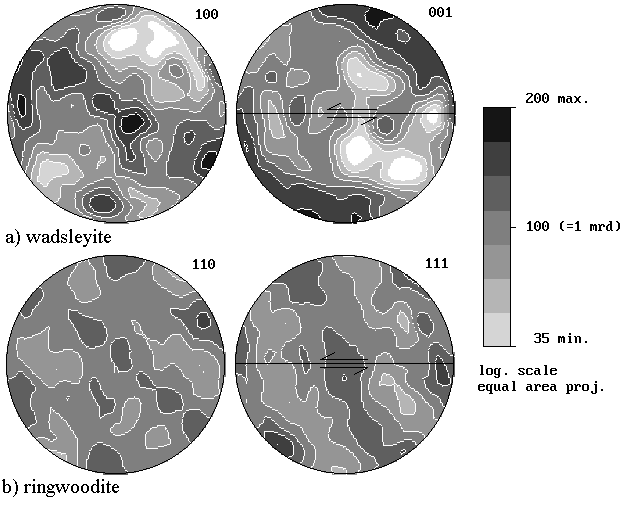

The rheology of transition zone minerals such as wadsleyite and ringwoodite is an important factor in the mechanics of mantle convection and the subduction of slabs of oceanic crust. The relative strengths of these minerals were investigated in a series of shear deformation experiments in a multianvil apparatus using a simple shear geometry (see Annual Report 1998). Single layers or pairs of different materials (e.g. forsterite-wadsleyite, wadsleyite-ringwoodite) were deformed under varying P,T conditions (10-15 GPa, 1100-1300°C) leading to shear strains of up to 200% in the individual layers. The crystallographic preferred orientation (texture) in a number of these samples was measured for the following reasons: 1) the presence or absence of a texture is characteristic of the deformation mechanism active under the respective P,T conditions; 2) the type and geometry of the texture may indicate intracrystalline slip systems; 3) the texture resulting from deformation can have a strong effect on the anisotropy of physical properties (e.g. seismic velocities) of the bulk material.
All three investigated minerals (forsterite containing 2% fayalite, wadsleyite with 10% fayalite and ringwoodite with 30% fayalite) developed characteristic textures during deformation indicating that the strain was, at least in part, accommodated by dislocation-controlled creep. The textures in forsterite are characterized by an alignment of {010} subparallel to the shear plane and <001> parallel with the shear direction; this slip system is activated only at relatively high stresses. Lowering the pressure on the pistons leads to a texture in which both <100> and the <001> axes are aligned with the shear direction. The {010}<100> texture is most often encountered in natural xenoliths, whereas the {010}<001> texture is rather rare. All of the investigated wadsleyite samples display a similar texture: the {001} planes are oriented subparallel to the shear plane and the <100> directions are aligned with the shear directions, pointing to a {001}<100> slip system that has been active during deformation (Fig. 3.1-21a). The texture in ringwoodite is similar to that found in fcc metals deformed in torsion, indicating the importance of {111} as the slip plane and <110> as the slip direction (Fig. 3.1-21b).
 |
Fig. 3.1-21: Crystallographic preferred orientations (textures) of wadsleyite and ringwoodite deformed in simple shear; shear plane (horizontal line) and shear sense are indicated; lower hemisphere projections; m.r.d. = multiples of random distribution. |
The presence of crystallographic preferred orientation indicates that the deformation was accommodated by dislocation creep. However the relatively high strain rates (ca. 10-4 sec-1) and high initial deviatoric stresses (probably in the GPa range) make an extrapolation to natural deformation conditions difficult. In future experiments we will try to minimize the unrealistically high initial deviatoric stresses at the beginning of the experiment in order to elucidate the influence of high pressures on texture development in these transition zone minerals.

Tel: +49-(0) 921 55 3700 / 3766, Fax: +49-(0) 921 55 3769, E-mail: bayerisches.geoinstitut(at)uni-bayreuth.de
 Previous page
Previous page